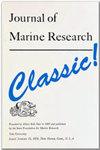Analisa Kesehatan Mangrove di Kawasan Ujung Piring dan Teluk Awur Menggunakan Sentinel-2A
IF 0.5
4区 地球科学
Q3 Earth and Planetary Sciences
引用次数: 0
Abstract
Ekosistem mangrove merupakan ekosistem dengan komponen sumberdaya alam meliputi bentang alam, flora, fauna, dan masyarakat sekitar dengan beragam fungsi seperti ekologis, ekonomis dan sosial. Alih fungsi lahan mangrove untuk tambak dan pemukiman yang masif dilakukan mengakibatkan kondisi mangrove di Ujung Piring dan Teluk Awur mengalami penurunan kualitas ekosistem mangrove. Informasi spasial kondisi terkini ekosistem mangrove yang belum tersedia mengakibatkan upaya pencegahan kerusakan dan konservasi ekosistem mangrove tidak berjalan maksimal. Tujuan penelitian ini adalah mengetahui sebaran, luas, dan kondisi kesehatan mangrove di kawasan Ujung Piring dan Teluk Awur menggunakan citra Sentinel 2A melalui penginderaan jauh dan validasi lapangan. Pendekatan penginderaan jauh memadukan composite band dengan supervised classification dilakukan untuk mengetahui sebaran dan metode Normalized Difference Vegetation Index (NDVI) untuk mengetahui luas dan kondisi kesehatan mangrove. Validasi lapangan menerapkan hemispherical photography untuk menganalisa tutupan kanopi mangrove di lapangan. Hasil penelitian menunjukkan mangrove kawasan Ujung Piring tersebar di area pantai, ekowisata, dan tambak. Luas mangrove di kawasan Ujung Piring sebesar 21,004 ha terdiri dari 17,519 ha (83,41%) kategori lebat; 2,527 ha (12,03%) kategori sedang; dan 0,958 ha (4,56%) kategori jarang. Mangrove kawasan Teluk Awur dapat dijumpai di area pantai, daerah konservasi mangrove, tambak, aliran sungai, pemukiman, dan lahan terbuka. Mangrove di kawasan Teluk Awur memilki luas 10,657 ha tersusun oleh 8,013 ha (75,1% kategori lebat); 0,688 ha (6,5%) kategori sedang; dan 1,956 ha (18,4%) kategori jarang. The mangrove ecosystem contains various natural resource components including landscapes, flora, fauna, and its surrounding communities with various ecological, economic, and social functions. Massive conversion of mangrove area for ponds and settlements has reduced the ecosystem quality of mangroves in Ujung Piring and Teluk Awur. The lack or even inexistence of spatial information regarding the current condition of the mangrove ecosystem has hindered the efforts to prevent damage and conserve mangrove ecosystem from running optimally. This research sought to examine the distribution, area, and health condition of mangroves in Ujung Piring and Teluk Awur areas using Sentinel-2A imagery by means of remote sensing and field validation. The remote sensing approach combined composite bands with supervised classification to determine the distribution and the Normalized Difference Vegetation Index (NDVI) method to determine the extent and health conditions of mangroves. The field validation applied hemispherical photography to analyze mangrove canopy cover in the field. The research results revealed that the mangroves in Ujung Piring area were distributed in coastal, ecotourism, and pond areas. The mangroves in Ujung Piring area measured 21.004 ha consisting of 17.519 ha (83.41%) in the dense category; 2,527 ha (12.03%) medium category; and 0.958 ha (4.56%) in sparse category. The mangroves in Teluk Awur area were found in coastal, mangrove conservation, pond, river, settlement, and open areas. The mangroves in Teluk Awur measured 10,657 ha consisting of 8,013 ha (75.1% dense category); 0.688 ha (6.5%) medium category; and 1,956 ha (18.4%) in sparse category.our海湾采用哨兵2a进行的Mangrove健康分析
红树林生态系统是一个由自然资源组成的生态系统,其组成包括地形、植物、动物和周边社区的生态、经济和社会等多种功能。通过对大型池塘和定居点的覆盖,红树林的土地功能得到了补偿,这导致了板块底部和Awur湾的红树林条件下降。最近还没有可用的红树林生态系统的空间信息,导致防止破坏和保护红树林生态系统的努力被打破。本研究的目标是了解板块端和Awur湾的mangrove分布、分布范围和健康状况,并通过遥感和现场验证对哨兵2A的印象。遥感方法将合成波段与显微分类法结合起来,以确定不同植被指数的分布和方法,以了解红树林的面积和健康状况。现场验证采用半球形摄影技术分析田野冠套。研究结果显示,红树林的端部分布在沿海、生态旅游和池塘。在板块末端的红树林面积为21,004 ha,由17.519 ha(83.41%)组成;1527 ha(12.03%)中级;而0.958 ha(4.56%)的类别是罕见的。Awur湾的Mangrove区域可以在沿海地区、Mangrove保护区、池塘、小溪、定居点和开放的土地上找到。Awur湾的红树林面积为10.657 ha,由8.013 ha (75.1%);0.688 ha(6.5%)中级;而1856 ha(18.4%)是稀有类别。红树林生态系统与多种生态环境、动植物、动物和其相互作用的公共性联系在一起。大量的锰链区域被低估了关于食物生态系统的某些不存在的信息这一研究有助于解决板块末端和海湾的分布、区域和健康状况。以检测分布和标准不同蔬菜指数的方法确定存在和健康的mangroves。分析卡通canopy封面。研究结果显示,在板块末端出现的猎物分布在海岸、生态环境和池塘地区。盘边的mangroves是21004 ha,记录在丹麦的17519 ha (88.41%);2,527 ha(12.03%)介质类别;*功夫好*该地区的红树林被发现在海岸、红树林保护、池塘、河口、空地和开放区域。位于海湾的mangroves是10.657 ha,提示8.013 ha(75.1%的丹麦类别);0.688 ha(6.5%)分类媒体;看吧看吧看吧看吧看吧看吧看吧看吧看吧看吧看吧看吧看吧看吧看吧看吧看吧看吧看吧看吧看吧看吧看吧看吧看吧看吧看吧看吧看吧看吧看吧看吧看吧看吧看吧看吧看吧看吧看吧看吧看吧看吧看吧看吧看吧看吧
本文章由计算机程序翻译,如有差异,请以英文原文为准。
求助全文
约1分钟内获得全文
求助全文
来源期刊

Journal of Marine Research
地学-海洋学
自引率
0.00%
发文量
1
审稿时长
3 months
期刊介绍:
The Journal of Marine Research publishes peer-reviewed research articles covering a broad array of topics in physical, biological and chemical oceanography. Articles that deal with processes, as well as those that report significant observations, are welcome. In the area of biology, studies involving coupling between ecological and physical processes are preferred over those that report systematics. Authors benefit from thorough reviews of their manuscripts, where an attempt is made to maximize clarity. The time between submission and publication is kept to a minimum; there is no page charge.
 求助内容:
求助内容: 应助结果提醒方式:
应助结果提醒方式:


